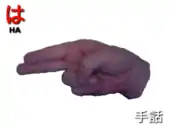Ha (kana)
Ha (hiragana: は, katakana: ハ) is one of the Japanese kana, each of which represent one mora. Both represent [ha]. They are also used as a grammatical particle (in such cases, they denote [wa], including in the greeting "kon'nichiwa") and serve as the topic marker of the sentence. は originates from 波 and ハ from 八.
| ha | |||
|---|---|---|---|
| |||
| transliteration | ha, wa | ||
| hiragana origin | 波 | ||
| katakana origin | 八 | ||
| Man'yōgana | 八 方 芳 房 半 伴 倍 泊 波 婆 破 薄 播 幡 羽 早 者 速 葉 歯 | ||
| Voiced Man'yōgana | 伐 婆 磨 魔 | ||
| spelling kana | はがきのハ Hagaki no "ha" | ||
| unicode | U+306F, U+30CF | ||
| braille | |||
| Note: This syllable was historically pronounced as "Pa". | |||
| kana gojūon | ||||||||||||||||||||||||||||||||||||||||||||||||||||||||||||
|---|---|---|---|---|---|---|---|---|---|---|---|---|---|---|---|---|---|---|---|---|---|---|---|---|---|---|---|---|---|---|---|---|---|---|---|---|---|---|---|---|---|---|---|---|---|---|---|---|---|---|---|---|---|---|---|---|---|---|---|---|
|
||||||||||||||||||||||||||||||||||||||||||||||||||||||||||||
| yori · koto · hentaigana | ||||||||||||||||||||||||||||||||||||||||||||||||||||||||||||
In the Sakhalin dialect of the Ainu language, the katakana ハ can be written as small ㇵ to represent a final h sound after an a sound (アㇵ ah).[1] This, along with other extended katakana, was developed by Japanese linguists to represent sounds in Ainu not present in standard Japanese katakana. When used as a particle, は is pronounced as わ [wa]. は is also pronounced as わ in some words.
| Form | Rōmaji | Hiragana | Katakana |
|---|---|---|---|
| Normal h- (は行 ha-gyō) |
ha | は | ハ |
| haa hā, hah |
はあ, はぁ はー |
ハア, ハァ ハー | |
| Addition dakuten b- (ば行 ba-gyō) |
ba | ば | バ |
| baa bā, bah |
ばあ, ばぁ ばー |
バア, バァ バー | |
| Addition handakuten p- (ぱ行 pa-gyō) |
pa | ぱ | パ |
| paa pā, pah |
ぱあ, ぱぁ ぱー |
パア, パァ パー |
Stroke order
 Stroke order in writing は |
 Stroke order in writing ハ |

The Hiragana は is made with three strokes:
- A vertical line on the left side with a small curve.
- A horizontal stroke near the center.
- A vertical stroke on the right at the center of the second stroke followed by a loop near the end.

The Katakana ハ is made with two strokes:
- A straight stroke from the top pointing towards the bottom left.
- Another straight stroke going the opposite way, i.e. from the top to the bottom right
The kana は is read as "wa" when it represents a particle.
Other communicative representations
| Japanese radiotelephony alphabet | Wabun code |
| はがきのハ Hagaki no "Ha" |
 |
|
 |
 |
| Japanese Navy Signal Flag | Japanese semaphore | Japanese manual syllabary (fingerspelling) | Braille dots-136 Japanese Braille |
- Full Braille representation
| は / ハ in Japanese Braille | |||||||||||
|---|---|---|---|---|---|---|---|---|---|---|---|
| は / ハ ha | ば / バ ba | ぱ / パ pa | はあ / ハー hā | ばあ / バー bā | ぱあ / パー pā | Other kana based on Braille は | |||||
| ひゃ / ヒャ hya | びゃ / ビャ bya | ぴゃ / ピャ pya | ひゃあ / ヒャー hyā | びゃあ / ビャー byā | ぴゃあ / ピャー pyā | ||||||
| Preview | は | ハ | ハ | ㇵ | ㋩ | |||||
|---|---|---|---|---|---|---|---|---|---|---|
| Unicode name | HIRAGANA LETTER HA | KATAKANA LETTER HA | HALFWIDTH KATAKANA LETTER HA | KATAKANA LETTER SMALL HA | CIRCLED KATAKANA HA | |||||
| Encodings | decimal | hex | decimal | hex | decimal | hex | decimal | hex | decimal | hex |
| Unicode | 12399 | U+306F | 12495 | U+30CF | 65418 | U+FF8A | 12789 | U+31F5 | 13033 | U+32E9 |
| UTF-8 | 227 129 175 | E3 81 AF | 227 131 143 | E3 83 8F | 239 190 138 | EF BE 8A | 227 135 181 | E3 87 B5 | 227 139 169 | E3 8B A9 |
| Numeric character reference | は | は | ハ | ハ | ハ | ハ | ㇵ | ㇵ | ㋩ | ㋩ |
| Shift JIS (plain)[2] | 130 205 | 82 CD | 131 110 | 83 6E | 202 | CA | ||||
| Shift JIS-2004[3] | 130 205 | 82 CD | 131 110 | 83 6E | 202 | CA | 131 241 | 83 F1 | ||
| EUC-JP (plain)[4] | 164 207 | A4 CF | 165 207 | A5 CF | 142 202 | 8E CA | ||||
| EUC-JIS-2004[5] | 164 207 | A4 CF | 165 207 | A5 CF | 142 202 | 8E CA | 166 243 | A6 F3 | ||
| GB 18030[6] | 164 207 | A4 CF | 165 207 | A5 CF | 132 49 153 56 | 84 31 99 38 | 129 57 188 57 | 81 39 BC 39 | ||
| EUC-KR[7] / UHC[8] | 170 207 | AA CF | 171 207 | AB CF | ||||||
| Big5 (non-ETEN kana)[9] | 198 211 | C6 D3 | 199 103 | C7 67 | ||||||
| Big5 (ETEN / HKSCS)[10] | 199 86 | C7 56 | 199 203 | C7 CB | ||||||
| Preview | ば | バ | ぱ | パ | ||||
|---|---|---|---|---|---|---|---|---|
| Unicode name | HIRAGANA LETTER BA | KATAKANA LETTER BA | HIRAGANA LETTER PA | KATAKANA LETTER PA | ||||
| Encodings | decimal | hex | decimal | hex | decimal | hex | decimal | hex |
| Unicode | 12400 | U+3070 | 12496 | U+30D0 | 12401 | U+3071 | 12497 | U+30D1 |
| UTF-8 | 227 129 176 | E3 81 B0 | 227 131 144 | E3 83 90 | 227 129 177 | E3 81 B1 | 227 131 145 | E3 83 91 |
| Numeric character reference | ば | ば | バ | バ | ぱ | ぱ | パ | パ |
| Shift JIS[2] | 130 206 | 82 CE | 131 111 | 83 6F | 130 207 | 82 CF | 131 112 | 83 70 |
| EUC-JP[4] | 164 208 | A4 D0 | 165 208 | A5 D0 | 164 209 | A4 D1 | 165 209 | A5 D1 |
| GB 18030[6] | 164 208 | A4 D0 | 165 208 | A5 D0 | 164 209 | A4 D1 | 165 209 | A5 D1 |
| EUC-KR[7] / UHC[8] | 170 208 | AA D0 | 171 208 | AB D0 | 170 209 | AA D1 | 171 209 | AB D1 |
| Big5 (non-ETEN kana)[9] | 198 212 | C6 D4 | 199 104 | C7 68 | 198 213 | C6 D5 | 199 105 | C7 69 |
| Big5 (ETEN / HKSCS)[10] | 199 87 | C7 57 | 199 204 | C7 CC | 199 88 | C7 58 | 199 205 | C7 CD |
See also
References
| Look up は, ば, or ぱ in Wiktionary, the free dictionary. |
- http://www.alanwood.net/unicode/katakana_phonetic_extensions.html
- Unicode Consortium (2015-12-02) [1994-03-08]. "Shift-JIS to Unicode".
- Project X0213 (2009-05-03). "Shift_JIS-2004 (JIS X 0213:2004 Appendix 1) vs Unicode mapping table".
- Unicode Consortium; IBM. "EUC-JP-2007". International Components for Unicode.
- Project X0213 (2009-05-03). "EUC-JIS-2004 (JIS X 0213:2004 Appendix 3) vs Unicode mapping table".
- Standardization Administration of China (SAC) (2005-11-18). GB 18030-2005: Information Technology—Chinese coded character set.
- Unicode Consortium; IBM. "IBM-970". International Components for Unicode.
- Steele, Shawn (2000). "cp949 to Unicode table". Microsoft / Unicode Consortium.
- Unicode Consortium (2015-12-02) [1994-02-11]. "BIG5 to Unicode table (complete)".
- van Kesteren, Anne. "big5". Encoding Standard. WHATWG.
- Soergel, Nicolas (3 October 2011). "Particle は (wa)". Nihongo Ichiban.


